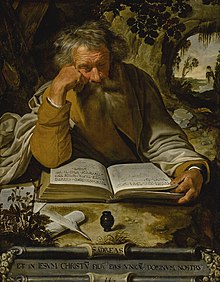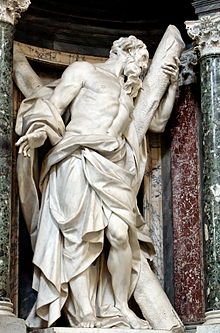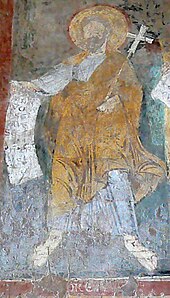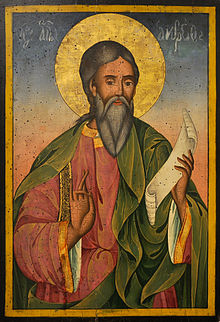Andrew the Apostle
Andrew the Apostle | |
|---|---|
 Saint Andrew the Apostle by Artus Wolffort | |
| Apostle | |
| Born | Early 1st century Bethsaida, Judea, Roman Empire |
| Died | Mid- to late 1st century Patras, Achaia, Roman Empire |
| Venerated in | All of Christianity |
| Canonized | Apostolic age by Pre-congregation |
| Feast | 30 November |
| Attributes | Old man with long (in the East often untidy) white hair and beard, holding the Gospel Book or scroll, sometimes leaning on a saltire |
| Patronage | Scotland, Barbados, Ukraine, Russia, Sicily, Greece, Cyprus, Romania, Patras, Diocese of Parañaque, City of Manila,[1] Amalfi, Luqa (Malta) and Prussia; Diocese of Victoria fishermen, fishmongers and rope-makers |
Andrew the Apostle (Greek: Ἀνδρέας, Andreas; from the early 1st century – mid to late 1st century AD; known by some as Saint Andrew), called in the Orthodox tradition Prōtoklētos (Πρωτόκλητος), or the First-called, was a Christian Apostle and the brother of Saint Peter.[2]
The name "Andrew" (Greek: manly, brave, from ἀνδρεία, Andreia, "manhood, valour"), like other Greek names, appears to have been common among the Jews, Christians, and other Hellenized people of the region. No Hebrew or Aramaic name is recorded for him. According to Orthodox tradition, the apostolic successor to Saint Andrew is Patriarch Bartholomew I.[3]
Life
The New Testament states that Andrew was the brother of Simon Peter,[4] by which it is inferred that he was likewise a son of John, or Jonah. He was born in the village of Bethsaida on the Sea of Galilee. Both he and his brother Peter were fishermen by trade, hence the tradition that Jesus called them to be his disciples by saying that he will make them "fishers of men" (Greek: ἁλιεῖς ἀνθρώπων, halieĩs anthrōpōn).[5] At the beginning of Jesus' public life, they were said to have occupied the same house at Capernaum.

The Gospel of John states that Andrew was a disciple of John the Baptist, whose testimony first led him, and another unnamed disciple of John the Baptist, to follow Jesus. Andrew at once recognized Jesus as the Messiah, and hastened to introduce him to his brother.[6] Thenceforth, the two brothers were disciples of Christ. On a subsequent occasion, prior to the final call to the Apostolate, they were called to a closer companionship, and then they left all things to follow Jesus.
In the gospels, Andrew is referred to as being present on some important occasions as one of the disciples more closely attached to Jesus.[7] Andrew told Jesus about the boy with the loaves and fishes (John 6:8), with Philip told Jesus about the Greeks seeking Him, and was present at the Last Supper.[8]

Eusebius in his church history 3,1 quotes Origen as saying Andrew preached in Scythia. The Chronicle of Nestor adds that he preached along the Black Sea and the Dnieper river as far as Kiev, and from there he traveled to Novgorod. Hence, he became a patron saint of Ukraine, Romania and Russia. According to tradition, he founded the See of Byzantium (Constantinople) in AD 38, installing Stachys as bishop. According to Hippolytus of Rome, he preached in Thrace, and his presence in Byzantium is also mentioned in the apocryphal Acts of Andrew, written in the 2nd century; Basil of Seleucia also knew of Apostle Andrew's mission in Thrace, as well as Scythia and Achaia.[9] This diocese would later develop into the Patriarchate of Constantinople. Andrew is recognized as its patron saint.
Andrew is said to have been martyred by crucifixion at the city of Patras (Patræ) in Achaea, on the northern coast of the Peloponnese. Early texts, such as the Acts of Andrew known to Gregory of Tours,[10] describe Andrew as bound, not nailed, to a Latin cross of the kind on which Jesus is said to have been crucified; yet a tradition developed that Andrew had been crucified on a cross of the form called Crux decussata (X-shaped cross, or "saltire"), now commonly known as a "Saint Andrew's Cross" — supposedly at his own request. As he deemed himself unworthy to be crucified on the same type of cross as Jesus had been.[11] "The familiar iconography of his martyrdom, showing the apostle bound to an X-shaped cross, does not seem to have been standardized before the later Middle Ages," Judith Calvert concluded after re-examining the materials studied by Louis Réau.[12]
The Acts of Andrew
The apocryphal Acts of Andrew, mentioned by Eusebius, Epiphanius and others, is among a disparate group of Acts of the Apostles that were traditionally attributed to Leucius Charinus. "These Acts (...) belong to the third century: ca. A.D. 260," was the opinion of M. R. James, who edited them in 1924. The Acts, as well as a Gospel of St Andrew, appear among rejected books in the Decretum Gelasianum connected with the name of Pope Gelasius I. The Acts of Andrew was edited and published by Constantin von Tischendorf in the Acta Apostolorum apocrypha (Leipzig, 1821), putting it for the first time into the hands of a critical professional readership. Another version of the Andrew legend is found in the Passio Andreae, published by Max Bonnet (Supplementum II Codicis apocryphi, Paris, 1895).
Relics


Relics of the Apostle Andrew are kept at the Basilica of St Andrew in Patras, Greece; the Duomo di Sant'Andrea, Amalfi, Italy; St Mary's Roman Catholic Cathedral, Edinburgh, Scotland;[6] and the Church of St Andrew and St Albert, Warsaw, Poland. There are also numerous smaller reliquaries throughout the world.
Andrew's remains were preserved at Patras. According to one legend, St. Regulus (Rule) was a monk at Patras, who was advised in a dream to hide some of the bones. Shortly thereafter, most of the relics were translated from Patras to Constantinople by order of the Roman emperor Constantius II around 357 and deposited in the Church of the Holy Apostles.[8]
Regulus was said to have had a second dream in which an angel advised him to take the hidden relics ‘to the ends of the earth’ for protection. Wherever he was shipwrecked, he was to build a shrine for them. St Rule set sail, taking with him a kneecap, an upper arm bone, three fingers and a tooth. He sailed west, towards the edge of the known world, and was shipwrecked on the coast of Fife, Scotland. However, the relics were probably brought to Britain in 597 as part of the Augustine Mission, and then in 732 to Fife, by Bishop Acca of Hexham, a well known collector of religious relics.[6]
The skull of St. Andrew, which had been taken to Constantinople was returned to Patras by Emperor Basil I, who ruled from 867 to 886.[13]
In 1208, following the sack of Constantinople, those relics of St. Andrew and St. Peter which remained in the imperial city were taken to Amalfi, Italy,[14] by Cardinal Peter of Capua, a native of Amalfi. A cathedral (Duomo), was built, dedicated to St. Andrew (as is the town itself), to house a tomb in its crypt where it is maintained that most of the relics of the apostle, including an occipital bone, remain.
Thomas Palaeologus was the youngest surviving son of Byzantine Emperor Manuel II Palaiologos. Thomas ruled the province of Morea, the medieval name for the Peloponnese. In 1461, when the Ottomans crossed the Strait of Corinth, Palaeologus fled Patras for exile in Italy, bringing with him what was purported to be the skull of St. Andrew. He gave the head to Pope Pius II, who had it enshrined in one of the four central piers of St. Peter's Basilica in the Vatican.
In September 1964, Pope Paul VI, as a gesture of goodwill toward the Greek Orthodox Church, ordered that all of the relics of St. Andrew that were in Vatican City be sent back to Patras. Cardinal Augustin Bea along with many other cardinals presented the skull to Bishop Constantine of Patras on 24 September 1964.[15][16] The cross of St. Andrew was taken from Greece during the Crusades by the Duke of Burgundy.[17][18] It was kept in the church of St. Victor in Marseilles[19][20] until it returned to Patras on 19 January 1980. The cross of the apostle was presented to the Bishop of Patras Nicodemus by a Catholic delegation led by Cardinal Roger Etchegaray. All the relics, which consist of the small finger, the skull (part of the top of the cranium of Saint Andrew), and the cross on which he was martyred, have been kept in the Church of St. Andrew at Patras in a special shrine and are revered in a special ceremony every 30 November, his feast day.
In 2006, the Catholic Church, again through Cardinal Roger Etchegaray, gave the Greek Orthodox Church another relic of St. Andrew.[21]
Traditions and legends
Georgia
The church tradition of Georgia regards St. Andrew as the first preacher of Christianity in the territory of Georgia and as the founder of the Georgian church. This tradition was apparently derived from the Byzantine sources, particularly Nicetas of Paphlagonia (died c. 890) who asserts that "Andrew preached to the Iberians, Sauromatians, Taurians, and Scythians and to every region and city, on the Black Sea, both north and south."[22] The version was adopted by the 10th-11th-century Georgian ecclesiastics and, refurbished with more details, was inserted in the Georgian Chronicles. The story of St. Andrew’s mission in the Georgian lands endowed the Georgian church with apostolic origin and served as a defense argument to George the Hagiorite against the encroachments from the Antiochian church authorities on autocephaly of the Georgian church. Another Georgian monk, Ephraim the Minor, produced a thesis, reconciling St. Andrew’s story with an earlier evidence of the 4th-century conversion of Georgians by St. Nino and explaining the necessity of the "second Christening" by Nino. The thesis was made canonical by the Georgian church council in 1103.[23][24]
Cyprus
Cypriot tradition holds that a ship which was transporting Saint Andrew went off course and ran aground. Upon coming ashore, Andrew struck the rocks with his staff at which point a spring of healing waters gushed forth. Using it, the sight of the ship's captain, who had been blind in one eye, was restored. Thereafter, the site became a place of pilgrimage and a fortified monastery stood there in the 12th century, from which Isaac Comnenus negotiated his surrender to Richard the Lionheart. In the 15th century, a small chapel was built close to the shore. The main monastery of the current church dates to the 18th century.
Other pilgrimages are more recent. The story is told that in 1895, the son of a Maria Georgiou was kidnapped. Seventeen years later, Saint Andrew appeared to her in a dream, telling her to pray for her son's return at the monastery. Living in Anatolia, she embarked on the crossing to Cyprus on a very crowded boat. As she was telling her story during the journey, one of the passengers, a young Dervish priest, became more and more interested. Asking if her son had any distinguishing marks, he stripped off his clothes to reveal the same marks and mother and son were thus reunited.[25]
Apostolos Andreas Monastery (Greek: Απόστολος Ανδρέας) is a monastery dedicated to Saint Andrew situated just south of Cape Apostolos Andreas, which is the north-easternmost point of the island of Cyprus, in Rizokarpason in the Karpass Peninsula. The monastery is an important site to the Cypriot Orthodox Church. It was once known as 'the Lourdes of Cyprus', served not by an organized community of monks but by a changing group of volunteer priests and laymen. Both Greek Cypriot and Turkish Cypriot communities consider the monastery a holy place. As such, it is visited by many people for votive prayers.
Malta

The first reference regarding the first small chapel at Luqa dedicated to Andrew dates to 1497. This chapel contained three altars, one of them dedicated to Andrew. The painting showing "Mary with Saints Andrew and Paul" was painted by the Maltese artist Filippo Dingli. At one time, many fishermen lived in the village of Luqa, and this may be the main reason behind choosing Andrew as patron saint. The statue of Andrew was sculpted in wood by Giuseppe Scolaro in 1779. This statue underwent several restoration works including that of 1913 performed by the Maltese artist Abraham Gatt. The Martyrdom of Saint Andrew on the main altar of the church was painted by Mattia Preti in 1687.
Romania
The official stance of the Romanian Orthodox Church is that Andrew preached the Gospel in the province of Dobruja (Scythia Minor) to the Daco-Romans, whom he is said to have converted to Christianity. This theory is based in part on some ancient Christian symbols found carved in a cave near Murfatlar and in historical springs. According to New World Encyclopedia[26] which quotes Hippolyte of Antioch, (died c. 250 C.E.) in his On Apostles, Origen in the third book of his Commentaries on the Genesis (254 C.E.), Eusebius of Caesarea in his Church History (340 C.E.), and other different sources, like the Usaard's Martyrdom written between 845-865, Jacobus de Voragine in Golden Legend (c. 1260), Saint Andrew preached in Scythia Minor. There are toponyms and numerous very old traditions (like carols) related to Saint Andrew, many of them having probably a pre-Christian substratum. There exists a cave where he supposedly preached, supposedly identified and called "Saint Andrew's Cave".[27][28]
According to some modern Romanian scholars, the idea of early Christianisation is unsustainable. They take the idea to be a part of an ideology of protochronism which purports that the Orthodox Church has been a companion and defender of the Romanian people for its entire history, which was then used for propaganda purposes during the communist era.[29] Several works show, in contrast, that communists did not use this idea for propaganda but rather acted strongly against religion, persecuting Christians and promoting atheism as the belief system.[30][31][32]
Another Romanian researcher, George Alexandrou,[20] although he denies this theory, maintains that St. Andrew spent 20 years in the territories of the Daco-Romans, preaching and teaching. Alexandrou also supposes that St. Andrews felt very close to the Dacians because they were monotheists. During that period St. Andrew traveled around the Lower Danube territories and along the coast of the Black Sea, but mostly he stayed in and around his cave in Dobruja (located in the vicinity of the Ion Corvin village). St. Andrew’s cave is still kept as a holy place. Later, John Cassian (360-435), Dionysius Exiguus (470-574) and Joannes Maxentius (leader of the so-called Scythian Monks) lived in the same area, known as Scythia Minor or Dobruja, in South East Romania.[33]

There are a few pre-Christian traditions connected to St. Andrew's Day, some of them having their origin in the Roman celebrations of Saturn.[34][35][36] The Dacian New Year took place from 14 November until 7 December; this was considered the interval when time began its course.[37] One of the elements that came from the Roman and Thracian celebrations concerned wolves. During this night, wolves are allowed to eat all the animals they want. It is said that they can speak, too, but anyone that hears them will soon die. Early on St. Andrew’s day, the mothers go into the garden and gather tree branches, especially from apple, pear and cherry trees, and also rosebush branches. They make a bunch of branches for each family member. The one whose bunch blooms by New Year's Day will be lucky and healthy the next year.
The best known tradition connected to this night concerns matrimony and premonitory dreams. Single girls must put under their pillow a branch of sweet basil. If someone takes the plants in their dreams, that means the girl will marry soon. They can also plant wheat in a dish and water it until New Year’s Day. The nicer the wheat looks that day, the better the year to come. Saint Andrew's name is known in Romania under diverse forms: Sfântul Andrei, Sânt Andrei, Sânedru [34]
Ukraine

Early Christian History in Ukraine holds that the apostle Andrew preached on the southern borders of modern-day Ukraine, along the Black Sea. Legend has it that he travelled up the Dnieper River and reached the future location of Kiev, where he erected a cross on the site where the St. Andrew's Church of Kiev currently stands, and prophesied the foundation of a great Christian city.[38]
It was in the obvious interest of Kievan Rus' and its later Russian and Ukraninian successors, striving in numerous ways to link themselves with the political and religious heritage of Byzantium, to claim such a direct visit from the famous. Claiming direct lineage from St. Andrew also had the effect of disregarding any theological leanings of Greek Orthodoxy over which disagreement arose, since the actual "indirect" proselytising via Byzantium was bypassed altogether. Still, as the same source quotes, Andrew only preached to the southern shore of the Black Sea (current Turkey).[citation needed]
Scotland

About the middle of the 10th century,[citation needed] Andrew became the patron saint of Scotland. Several legends state that the relics of Andrew were brought by divine guidance from Constantinople to the place where the modern town of St Andrews stands today (Gaelic, Cill Rìmhinn).
The oldest surviving manuscripts are two: one is among the manuscripts collected by Jean-Baptiste Colbert and willed to Louis XIV of France, now in the Bibliothèque Nationale, Paris, the other is the Harleian Mss in the British Library, London. They state that the relics of Andrew were brought by one Regulus to the Pictish king Óengus mac Fergusa (729–761). The only historical Regulus (Riagail or Rule) whose name is preserved in the tower of St Rule was an Irish monk expelled from Ireland with Saint Columba; his dates, however, are c 573 – 600. There are good reasons for supposing that the relics were originally in the collection of Acca, bishop of Hexham, who took them into Pictish country when he was driven from Hexham (c. 732), and founded a see, not, according to tradition, in Galloway, but on the site of St Andrews.

According to legend, in 832 AD, Óengus II led an army of Picts and Scots into battle against the Angles, led by Æthelstan, near modern-day Athelstaneford, East Lothian. The legend states that he was heavily outnumbered and hence whilst engaged in prayer on the eve of battle, Óengus vowed that if granted victory he would appoint Saint Andrew as the Patron Saint of Scotland. On the morning of battle white clouds forming an X shape in the sky were said to have appeared. Óengus and his combined force, emboldened by this apparent divine intervention, took to the field and despite being inferior in numbers were victorious. Having interpreted the cloud phenomenon as representing the crux decussata upon which Saint Andrew was crucified, Óengus honoured his pre-battle pledge and duly appointed Saint Andrew as the Patron Saint of Scotland. The white saltire set against a celestial blue background is said to have been adopted as the design of the flag of Scotland on the basis of this legend.[39] However, there is evidence that Andrew was venerated in Scotland before this.

Andrew's connection with Scotland may have been reinforced following the Synod of Whitby, when the Celtic Church felt that Columba had been "outranked" by Peter and that Peter's brother would make a higher ranking patron. The 1320 Declaration of Arbroath cites Scotland's conversion to Christianity by Andrew, "the first to be an Apostle". Numerous parish churches in the Church of Scotland and congregations of other Christian churches in Scotland are named after Andrew. The national church of the Scottish people in Rome, Sant'Andrea degli Scozzesi is dedicated to St Andrew.
A local superstition uses the cross of Saint Andrew as a hex sign on the fireplaces in northern England and Scotland to prevent witches from flying down the chimney and entering the house to do mischief. By placing the St Andrew's cross on one of the fireplace posts or lintels, witches are prevented from entering through this opening. In this case, it is similar to the use of a witch ball, although the cross will actively prevent witches from entering, and the witch ball will passively delay or entice the witch, and perhaps entrap it.
Legacy

Andrew is the patron saint of several countries and cities including: Barbados, Romania, Russia, Scotland, Ukraine, Amalfi in Italy, Esgueira in Portugal, Luqa in Malta, Parañaque in the Philippines and Patras in Greece. He was also the patron saint of Prussia and of the Order of the Golden Fleece. He is considered the founder and the first bishop of the Church of Byzantium and is consequently the patron saint of the Ecumenical Patriarchate of Constantinople.
The flag of Scotland (and consequently the Union Flag and that of its commonwealth countries) feature St Andrew's saltire cross. The saltire is also the flag of Tenerife, the former flag of Galicia and the naval jack of Russia. The Confederate flag also features a saltire commonly referred to as a St Andrew's cross, although its designer, William Porcher Miles, said he changed it from an upright cross to a saltire so that it would not be a religious symbol but merely a heraldic device. The Florida and Alabama flags also show that device.
The feast of Andrew is observed on 30 November in both the Eastern and Western churches, and is the national day of Scotland. In the traditional liturgical books of the Catholic Church, the feast of St. Andrew is the first feast day in the Proper of Saints.
See also
- New Saint Andrews College
- Order of Saint Andrew
- Patron saints of places
- Santo André — an industrial town in Brazil
- Saint Andrew of Patras
- St. Andrew's College (Ontario), an all-boys independent school in Ontario, Canada named after St. Andrew. On the driveway to the main building, there is the St. Andrew statue
- Universidad de San Andrés — Argentina, named after the saint
- University of St Andrews — named after the Royal Burgh of St Andrews, which was named after the saint
Notes
- ^ Etravel Pilipinas. "Philippine Heroes: Gat Andres Bonifacio y de Castro". Etravel Pilipinas. Retrieved 13 August 2012.
- ^ "St Andrew".
- ^ Apostolic Succession of the Great Church of Christ, Ecumenical Patriarchate, retrieved 2 August 2014
- ^ Butler, Alban. The Lives of the Fathers, Martyrs and Other Principal Saints, Vol. III
- ^ Metzger & Coogan (1993) Oxford Companion to the Bible, p 27.
- ^ a b c "National Shrine to St Andrew in Edinburgh Scotland". Stmaryscathedral.co.uk. Retrieved 6 September 2013.
- ^ Mark 13:3; John 6:8, 12:22; but in Acts there is only one mention of him.1:13
- ^ a b "MacRory, Joseph. "St. Andrew." The Catholic Encyclopedia. Vol. 1. New York: Robert Appleton Company, 1907. 29 Oct. 2012". Newadvent.org. 1 March 1907. Retrieved 6 September 2013.
- ^ Encyclopedia of early Christianity by Everett Ferguson, p. 51.
- ^ In Monumenta Germaniae Historica II, cols. 821-847, translated in M.R. James, The Apocryphal New Testament (Oxford) reprinted 1963:369.
- ^ The legends surrounding Andrew are discussed in F. Dvornik, "The Idea of Apostolicity in Byzantium and the Legend of the Apostle Andrew", Dumbarton Oaks Studies, IV (Cambridge) 1958.
- ^ Judith Calvert, "The Iconography of the St. Andrew Auckland Cross", The Art Bulletin 66.4 (December 1984:543-555) p. 545, note 12; according to Louis Réau, Iconographie de l'art chrétien III.1 (Paris) 1958:79, St. Andrew's Cross appeared for the first time in the tenth century, but did not become an iconographic standard before the seventeenth. Calvert was unable to find a sculptural representation of Andrew on the saltire cross earlier than an architectural capital from Quercy, of the early twelfth century.
- ^ Christodoulou, Alexandros. "St. Andrew, Christ’s First-Called Disciple", Pemptousia
- ^ National Archives of Scotland (23 November 2011). "St. Andrew in the National Archives of Scotland". Nas.gov.uk. Retrieved 6 September 2013.
- ^ "Catholic Herald 2 October 1964". Archive.catholicherald.co.uk. Retrieved 6 September 2013.
- ^ Reception of the precious skull of St. Andrew (in Greek)
- ^ "La croix de Saint André". Vexil.prov.free.fr. Retrieved 6 September 2013.
- ^ Charlotte Denoël. Saint André: culte et iconographie en France (Ve -XVe siècles). Paris : École nationale des chartes, 2004
- ^ "Abbaye Saint-Victor de Marseille, monuments historiques en France (in French)". Monumentshistoriques.free.fr. Retrieved 6 September 2013.
- ^ a b George Alexandrou, THE ASTONISHING MISSIONARY JOURNEYS OF THE APOSTLE ANDREW, Road to Emmaus,Vol. V, No. 4, pp.43-45
- ^ Relic of St. Andrew Given to Greek Orthodox Church. Zenit News Agency (via Zenit.org). Published: 27 February 2006.
- ^ Peterson, Peter Megill (1958), Andrew, Brother of Simon Peter: His History and Legends, p. 20. E. J. Brill
- ^ Rapp, Stephen H. (2003), Studies in Medieval Georgian Historiography: Early Texts And Eurasian Contexts, p. 433. Peeters Publishers, ISBN 90-429-1318-5
- ^ Djobadze, Wachtang Z., "Materials for the Study of Georgian Monasteries in the Western Environs of Antioch on the Orontes", pp. 82-83. Corpus Scriptorum Christianorum Orientalium, vol. 372, subsidia 48. Louvain, 1976.
- ^ "Apostolos Andreas Monastery, Karpaz, North Cyprus". Whatson-northcyprus.com. Retrieved 13 August 2012.
- ^ "St. Andrew in Romania".
- ^ "St. Andrew's cave". April 2014.
- ^ Andreea Dogar, "Apostolul Andrei: Ne-a creștinat sau nu Cel Dintâi Chemat?", in National Geographic România, nr. 116, December 2012, p. 54-71
- ^ Lavinia Stan, Lucian Turcescu, Religion and Politics in Post-Communist Romania, Oxford University Press, 2007, p.48
- ^ "Christian persecution in Romania".
- ^ "The Calvary of Romania".
- ^ "Persecution of Christians in the Eastern Bloc".
- ^ Mircea Păcurariu- Sfinţi daco-români şi români, EDITURA MITROPOLIEI MOLDOVEI ŞI BUCOVINEI, IAŞI – 1994
- ^ a b Tudor Pamfil, Mitologia poporului roman, Editura Saeculum, 2007
- ^ Maria Filipoiu, Traditii crestine si ritualuri populare romanesti, Ed. Paideia, 2009
- ^ "St. Andrew's Day in Romania". Traditionsacrosseurope.wordpress.com. 25 November 2008. Retrieved 6 September 2013.
- ^ Tudor Pamfil, Sărbătorile de toamnă şi postul Crăciunului - Bucureşti, 1914, p.127-128
- ^ Lytvynchuk, Janna. St. Andrew's Church, p. 7, Kiev: Anateya, 2006, ISBN 966-8668-22-7
- ^ Parker Lawson, John (1848). History of the Abbey and Palace of Holyroodhouse. p. 169.
References
- Metzger, Bruce M. (ed); , Michael D. Coogan (ed) (1993). The Oxford Companion to the Bible. Oxford, UK: Oxford University Press. ISBN 0-19-504645-5.
{{cite book}}:|first=has generic name (help) - Attwater, Donald and Catherine Rachel John. The Penguin Dictionary of Saints. 3rd edition. New York: Penguin Books, 1993. ISBN 0-14-051312-4.
External links
- Andreas: The Legend of St. Andrew translated by Robert Kilburn Root, 1899, from Project Gutenberg
- Paintings and Statues of Saint Andrew in Malta and around the world
- National Shrine to St Andrew in Edinburgh Scotland
- Grimm's Saga No. 150 about St. Andrew
- "Saint Andrew" at the Christian Iconography website
- "The Life of St. Andrew" from Caxton's translation of the Golden Legend
- 1st-century births
- 1st-century deaths
- 1st-century Romans
- Eastern Orthodox saints
- Ante-Nicene Christian martyrs
- Andrew the Apostle
- Assyrian Church of the East saints
- Saints from the Holy Land
- People executed by crucifixion
- Roman-era Jews
- 1st-century bishops
- Saints of the Golden Legend
- Anglican saints
- People celebrated in the Lutheran liturgical calendar
- History of Christianity in Ukraine
- Syriac Orthodox Church saints
- Coptic Orthodox saints
- Saints of the Armenian Apostolic Church
